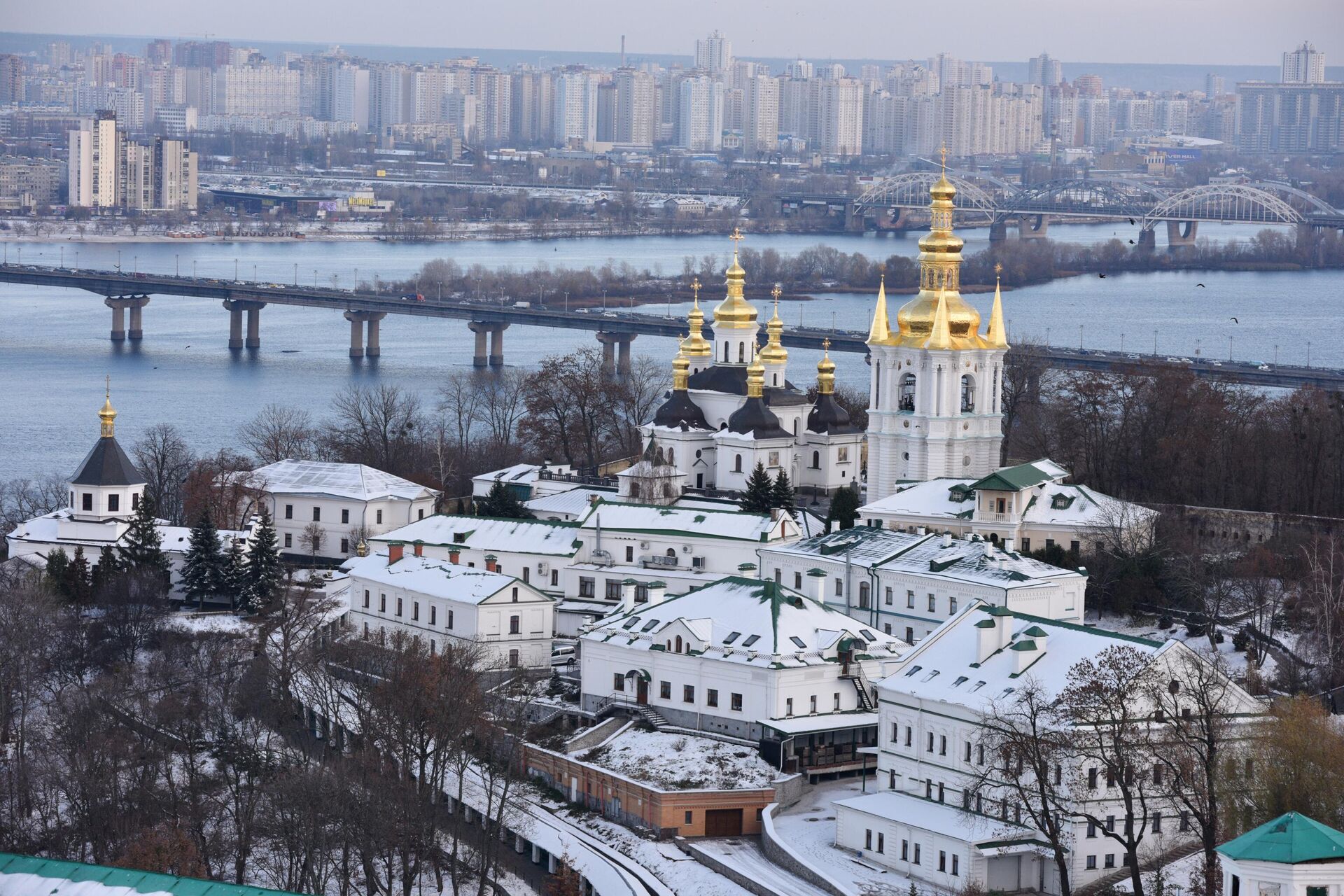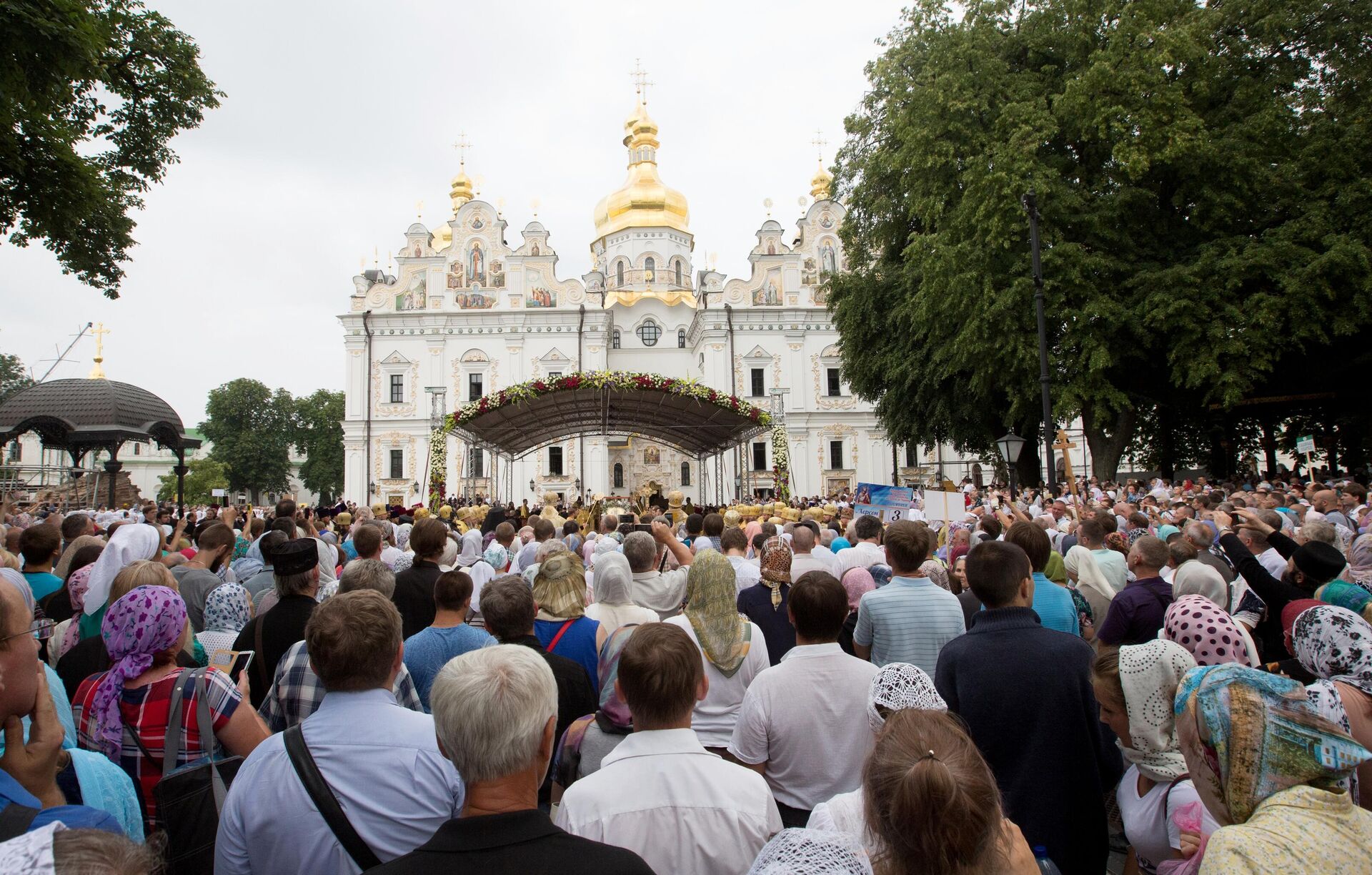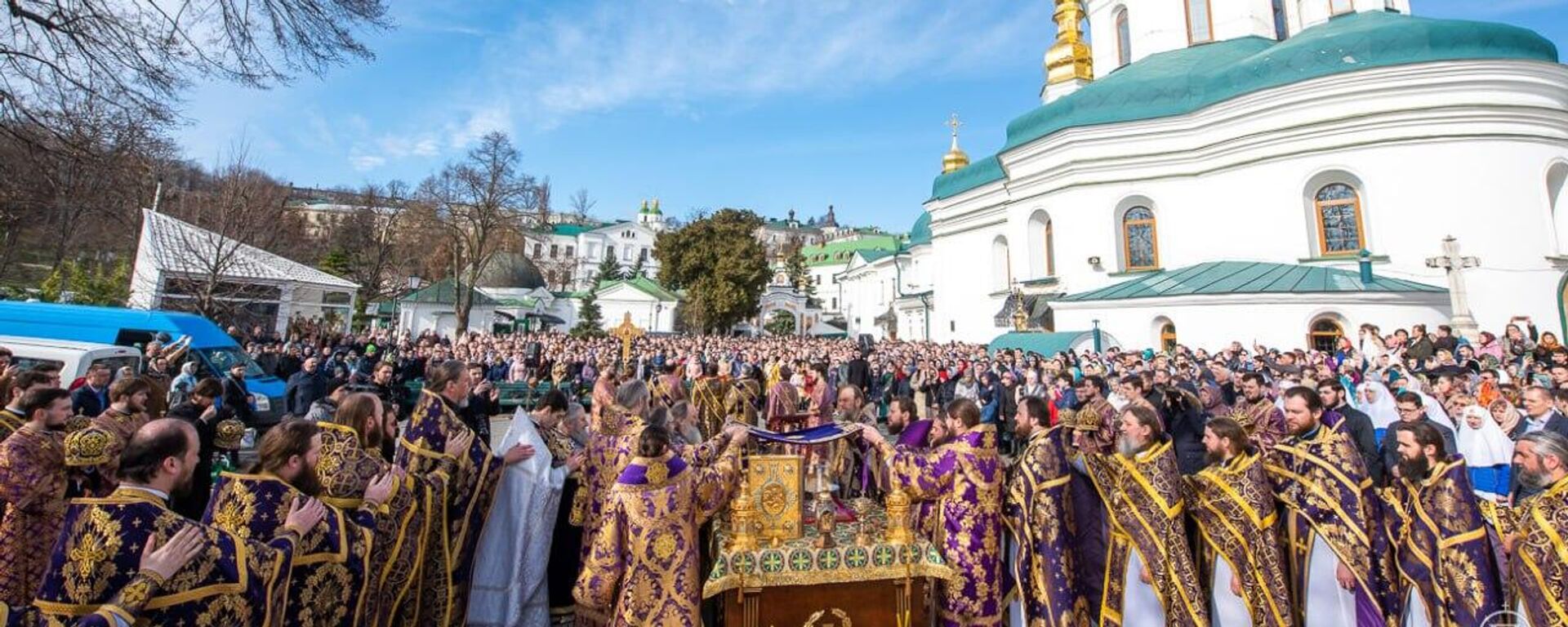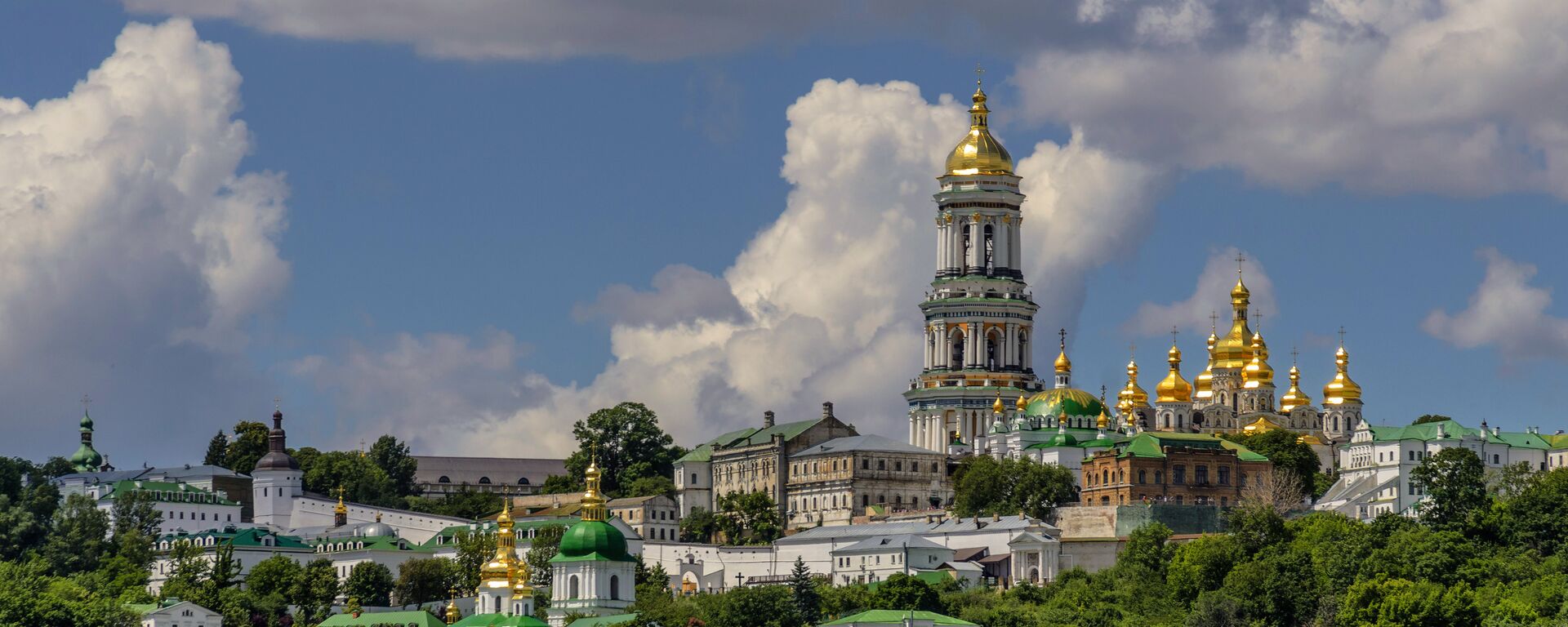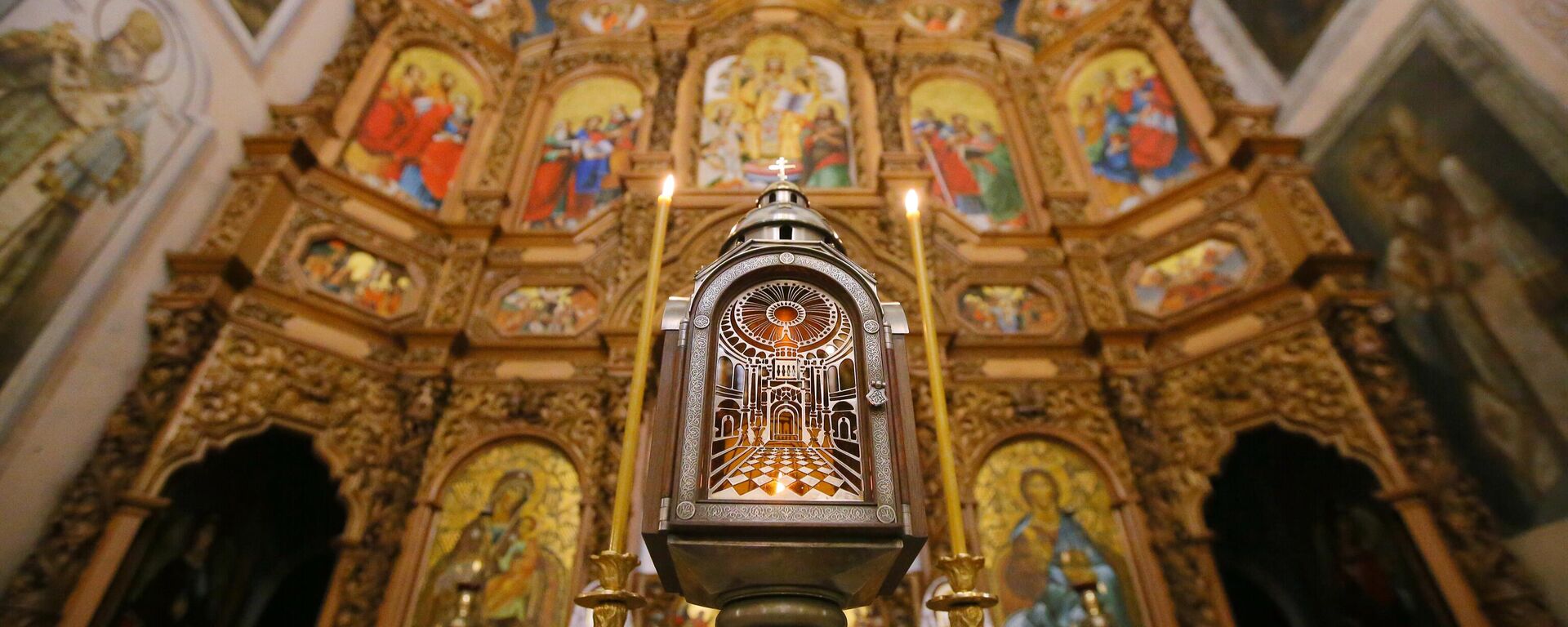https://sputnikglobe.com/20230328/what-happened-to-the-orthodox-church-in-ukraine-1108821316.html
What Happened to the Orthodox Church in Ukraine?
What Happened to the Orthodox Church in Ukraine?
Sputnik International
Kiev's famous Pechersk Lavra monastery is one of the oldest and most-revered holy places in the Eastern Orthodox religion. But now the complex has become a battleground in the assault on Russian culture by the Zelensky regime.
2023-03-28T14:15+0000
2023-03-28T14:15+0000
2023-03-28T14:15+0000
kiev
ukraine
monks
russian orthodox church
russian orthodox church outside russia (rocor)
volodymyr zelensky
greek orthodox church
sputnik explains
https://cdn1.img.sputnikglobe.com/img/106471/83/1064718373_0:30:4830:2747_1920x0_80_0_0_2c2697000c97aaa945311e07438e9098.jpg
As the Ukrainian government's deadline of March 29 for the monks to be evicted from the thousand-year-old site apporaches, a multitude of believers defiantly gathered at the Pechersk Lavra monastery on Sunday for prayers. The battle revolves around the Kiev regime's attempts to force the Ukrainian Orthodox Church — Moscow Patriarchate (UOC-MP), the historically-established wing of the 'autocephalous' or self-governing Eastern Orthodox religion in Ukraine, to renounce the leadership of the Moscow Patriarchate.The persecution of the UOC-MP has escalated despite the fact that the church distanced itself from Moscow after Russia launched its military operation to demilitarize and de-Nazify Ukraine in February 2022.The Zelensky government has demanded that the congregation join the Ukrainian Orthodox Church – Kiev Patriarchate (UOC-KP) and the Ukrainian Autocephalous Orthodox Church (UAOC) — both founded in the early 1990s at the time of the dissolution of the Soviet Union — in recognizing the sole authority of the unofficial Kiev Patriarchate, led by defrocked metropolitan Patriarch Filaret."We will continue these moves, and not allow a terrorist state" — a reference to Russia — "any opportunity to manipulate our people’s spirituality or destroy our Ukrainian shrines," he continued.The UOC-MP, in turn, appealed to Zelensky this month to change course, denying that it was disloyal to Ukraine.The synod appealed to Zelensky to "ensure the right to freedom of conscience and religion for our faithful, and to prevent the adoption of anti-constitutional laws against the Church."The Kiev Pechersk Lavra TodayThe Kiev Pechersk Lavra, also known as the Monastery of the Caves, is the oldest and one of the most revered monastic sites in the Russian Orthodox Church and a center of worship and pilgrimages. It sits above the western bank of the Dnepr River just south of the Ukrainian capital's center.The caves of St Anthony — Ukraine's first Christian monk — that the monastery sits on were home to the original monks who founded the community in 1051 AD. They have since become a mausoleum, the final resting place of famous Russian leaders and holy men, including the legendary Ilya Muromets and Saints Kuksha, Alipy, Agapetus and Barlaam — all of whom were given the epithet 'of the caves'. The head of first-century Roman Pope Clement I is also said to be among the holy relics in the catacombs.The original 11th-century church - the Cathedral of the Dormition - was destroyed by explosives in 1941 during the Nazi occupation of Ukraine. It was rebuilt only by 2000.What's Ukraine's Biggest Church?Despite Ukrainian nationalism's rejection of all things Russian, the people still embrace the eastern church.Of the Orthodox congregation, 29% are UOC-KP affiliated while 13% are affiliated with the Moscow Patriarchate church, with just a fraction of a percentage point attending UAOC services. Out of the remaining quarter, most said they were "simply Orthodox" while a few did not know which patriarchate they were meant to follow.When Did Ukraine Become a Christian Country?The history of Christianity in Ukraine begins with the legend that St. Andrew the Apostle traveled to the future site of Kiev in the first century, and prophesized that a great city would be built there. According to various historical estimates, the city of Kiev appeared between 8th and 10th centuries AD. But Christianity came there a bit later.Around 988 AD, Vladimir the Great, Grand Prince of Kiev, was baptized as a Christian, launching more than a thousand years of Orthodox worship in Russian lands.Vladimir reputedly sent envoys to study the religions of neighboring peoples. He rejected Islam for prohibiting alcohol, declaring that "drinking is the joy of all Rus'." After questioning Jewish representatives, Vladimir decided that God had forsaken them by allowing Jerusalem to fall to the Muslims.History records that the prince's envoys were unimpressed by the churches of the neighboring Germans, who worshipped in Latin, but were overawed by festive Byzantine rituals they witnessed in Constantinople.After capturing the Greek Crimean colony of Chersonesus from the Byzantines in 988, Vladimir proposed marriage to Emperor Basil II's sister Anna — ultimately making him the first 'barbarian' to join the royal dynasty of Constantinople. The prince was baptized before their wedding, taking the Christian name of Basil in honor of his brother-in-law.Kiev declined in wealth and importance in the 13th century after its conquest and sacking by the Mongols. At the same time, Moscow rose as the capital of the Russian nation and the center of its Orthodox church — often dubbed the 'Third Rome' after Constantinople.What Percentage of Russia is Orthodox?By contrast, a 2022 survey found that more than two-thirds of Russia's 147 million people follow the Orthodox faith — suggesting a total congregation of 100 million souls, almost half of the 220 million Eastern Orthodox believers worldwide.The Russian Orthodox Church is one of many 'autocephalous' branches of the Eastern Orthodox religion, which asserts a direct descent from the church founded by the disciples of Christ.The Great Schism of 1054 split the dominant Nicene tradition of Christianity between Constantinople — modern-day Istanbul — and Rome, leaving the Orthodox and Catholic faiths.The divide, which escalated through a series of tit-for-tat excommunications of priests by Byzantine patriarchs and Roman popes, was sparked by a theological disagreement about the nature of the holy trinity.The Russian church is part of the broader Eastern Orthodox faith. While the Ecumenical Patriarch of Constantinople, Bartholomew I, is held as the "first among equals" in the orthodox religion, Patriarch Kirill of Moscow is its head.Unlike the Roman Catholic church, Russian Orthodoxy allows married men to serve as priests, as long as they are wed before they are ordained. Those 'white' priests are distinct from the 'black' monks who undergo a separate rite and dedicate their lives to the monasteries.
https://sputnikglobe.com/20230326/thousands-attend-service-at-kiev-pechersk-lavra-as-monks-brace-for-eviction-by-zelensky-regime-1108799965.html
https://sputnikglobe.com/20230314/russia-alerts-un-osce-to-ukraines-plan-to-evict-monks-from-holy-orthodox-christian-site-1108386954.html
https://sputnikglobe.com/20230311/ukrainian-opposition-leader-satanic-zelensky-regime-wont-be-able-to-destroy-orthodox-faith-1108293305.html
kiev
ukraine
Sputnik International
feedback@sputniknews.com
+74956456601
MIA „Rossiya Segodnya“
2023
James Tweedie
https://cdn1.img.sputnikglobe.com/img/07e4/08/1c/1080307270_0:3:397:400_100x100_80_0_0_7777393b9b18802f2e3c5eaa9cbcc612.png
James Tweedie
https://cdn1.img.sputnikglobe.com/img/07e4/08/1c/1080307270_0:3:397:400_100x100_80_0_0_7777393b9b18802f2e3c5eaa9cbcc612.png
News
en_EN
Sputnik International
feedback@sputniknews.com
+74956456601
MIA „Rossiya Segodnya“
Sputnik International
feedback@sputniknews.com
+74956456601
MIA „Rossiya Segodnya“
James Tweedie
https://cdn1.img.sputnikglobe.com/img/07e4/08/1c/1080307270_0:3:397:400_100x100_80_0_0_7777393b9b18802f2e3c5eaa9cbcc612.png
ukraine, kiev, eastern orthodox church, russian orthodox church, pechersk lavra, volodymyr zelensky, kyiv pechersk lavra news, kyiv pechersk lavra, pechersk lavra, kyiv-pechersk lavra, lavra in kiev, what happened to orthodox church in ukraine, russian orthodox church, russian orthodox church in ukraine, ukrainian orthodox church moscow patriarchate, orthodox church in ukraine, un report discrimination against ukrainian orthodox church, who owns the pecherska lavra
ukraine, kiev, eastern orthodox church, russian orthodox church, pechersk lavra, volodymyr zelensky, kyiv pechersk lavra news, kyiv pechersk lavra, pechersk lavra, kyiv-pechersk lavra, lavra in kiev, what happened to orthodox church in ukraine, russian orthodox church, russian orthodox church in ukraine, ukrainian orthodox church moscow patriarchate, orthodox church in ukraine, un report discrimination against ukrainian orthodox church, who owns the pecherska lavra
What Happened to the Orthodox Church in Ukraine?
Kiev's renowned Pechersk Lavra monastery, with its gleaming gilded domes, is one of the oldest and most revered holy places in the Eastern Orthodox religion. But now this historic religious site has somehow morphed into a battleground in the Zelensky regime’s assault on Russian culture.
As the Ukrainian government's deadline of March 29 for the monks to be evicted from the thousand-year-old site apporaches, a multitude of believers defiantly gathered at the
Pechersk Lavra monastery on Sunday for prayers.
The battle revolves around the Kiev regime's attempts to force the Ukrainian Orthodox Church — Moscow Patriarchate (UOC-MP), the historically-established wing of the 'autocephalous' or self-governing Eastern Orthodox religion in Ukraine, to renounce the leadership of the Moscow Patriarchate.
The
persecution of the UOC-MP has escalated despite the fact that the church distanced itself from Moscow after Russia launched its military operation to demilitarize and de-Nazify Ukraine in February 2022.
The Zelensky government has demanded that the congregation join the Ukrainian Orthodox Church – Kiev Patriarchate (UOC-KP) and the Ukrainian Autocephalous Orthodox Church (UAOC) — both founded in the early 1990s at the time of the dissolution of the Soviet Union — in recognizing the sole authority of the unofficial Kiev Patriarchate, led by defrocked metropolitan Patriarch Filaret.
"Moves are underway to strengthen our spiritual independence," Zelensky said earlier in March, insisting that his crusade against the church was "quite legitimate."
"We will continue these moves, and not allow a terrorist state" — a reference to Russia — "any opportunity to manipulate our people’s spirituality or destroy our Ukrainian shrines," he continued.
The UOC-MP, in turn, appealed to Zelensky this month to change course, denying that it was disloyal to Ukraine.
"Our Church, to which many millions of fellow citizens belong, has always educated its flock to love their motherland, be worthy citizens of the state, and fulfill their civic duties with dignity," the UOC Holy Synod said, stressing that it was "the first to condemn" the Russian military operation and to "call on its believers to defend their native land."
The synod appealed to Zelensky to "ensure the right to freedom of conscience and religion for our faithful, and to prevent the adoption of anti-constitutional laws against the Church."
The Kiev Pechersk Lavra Today
The Kiev Pechersk Lavra, also known as the Monastery of the Caves, is the oldest and one of the most revered monastic sites in the Russian Orthodox Church and a center of worship and pilgrimages. It sits above the western bank of the Dnepr River just south of the Ukrainian capital's center.
The caves of St Anthony — Ukraine's first Christian monk — that the monastery sits on were home to the original monks who founded the community in 1051 AD. They have since become a mausoleum, the final resting place of famous Russian leaders and holy men, including the legendary Ilya Muromets and Saints Kuksha, Alipy, Agapetus and Barlaam — all of whom were given the epithet 'of the caves'. The head of first-century Roman Pope Clement I is also said to be among the holy relics in the catacombs.
The original 11th-century church - the Cathedral of the Dormition - was destroyed by explosives in 1941 during the Nazi occupation of Ukraine. It was rebuilt only by 2000.
What's Ukraine's Biggest Church?
Despite Ukrainian nationalism's rejection of all things Russian, the people still embrace the eastern church.
A survey of religious beliefs in 2018 found that 87% of Ukrainians consider themselves to be Christians, of which two-thirds identified as Orthodox and one in ten as Catholic — almost all adherents of the 'Greek Rite'.
Of the Orthodox congregation, 29% are UOC-KP affiliated while 13% are affiliated with the Moscow Patriarchate church, with just a fraction of a percentage point attending UAOC services. Out of the remaining quarter, most said they were "simply Orthodox" while a few did not know which patriarchate they were meant to follow.
When Did Ukraine Become a Christian Country?
The history of Christianity in Ukraine begins with the legend that St. Andrew the Apostle traveled to the future site of Kiev in the first century, and prophesized that a great city would be built there. According to various historical estimates, the city of Kiev appeared between 8th and 10th centuries AD. But Christianity came there a bit later.
Around 988 AD, Vladimir the Great, Grand Prince of Kiev, was baptized as a Christian, launching more than a thousand years of Orthodox worship in Russian lands.
Vladimir reputedly sent envoys to study the religions of neighboring peoples. He rejected Islam for prohibiting alcohol, declaring that "drinking is the joy of all Rus'." After questioning Jewish representatives, Vladimir decided that God had forsaken them by allowing Jerusalem to fall to the Muslims.
History records that the prince's envoys were unimpressed by the churches of the neighboring Germans, who worshipped in Latin, but were overawed by festive Byzantine rituals they witnessed in Constantinople.
After capturing the Greek Crimean colony of Chersonesus from the Byzantines in 988, Vladimir proposed marriage to Emperor Basil II's sister Anna — ultimately making him the first 'barbarian' to join the royal dynasty of Constantinople. The prince was baptized before their wedding, taking the Christian name of Basil in honor of his brother-in-law.
Kiev declined in wealth and importance in the 13th century after its conquest and sacking by the Mongols. At the same time, Moscow rose as the capital of the Russian nation and the center of its Orthodox church — often dubbed the 'Third Rome' after Constantinople.
What Percentage of Russia is Orthodox?
By contrast, a
2022 survey found that more than two-thirds of Russia's 147 million people follow the Orthodox faith — suggesting a total congregation of 100 million souls, almost half of the 220 million Eastern Orthodox believers worldwide.
The Russian Orthodox Church is one of many 'autocephalous' branches of the Eastern Orthodox religion, which asserts a direct descent from the church founded by the disciples of Christ.
The Great Schism of 1054 split the dominant Nicene tradition of Christianity between Constantinople — modern-day
Istanbul — and Rome, leaving the Orthodox and Catholic faiths.
The divide, which escalated through a series of tit-for-tat excommunications of priests by Byzantine patriarchs and Roman popes, was sparked by a theological disagreement about the nature of the holy trinity.
The Russian church is part of the broader Eastern Orthodox faith. While the Ecumenical Patriarch of Constantinople, Bartholomew I, is held as the "first among equals" in the orthodox religion, Patriarch Kirill of Moscow is its head.
Unlike the Roman Catholic church, Russian Orthodoxy allows married men to serve as priests, as long as they are wed before they are ordained. Those 'white' priests are distinct from the 'black' monks who undergo a separate rite and dedicate their lives to the monasteries.

